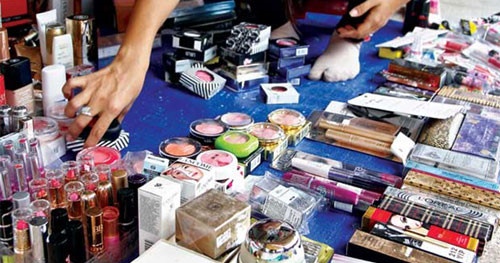counterfeit goods thrive because consumers are cheap
Nguyen Thu Ha bought a pair of Gucci shoes for only 1/10th of the same pair she had seen at an Italian high-end brand’s store abroad.
Although she feels different from the pair she tried, she seems very happy.
“I know this is a fake. I’m not fooled here. It doesn’t matter because these things are so beautiful,” she said.
Like Ms. Ha, many consumers in Hanoi prefer to buy counterfeit goods from glasses, shoes, clothes to handbags …, although they know it is counterfeit, illegal goods.
Cheap prices are often the main reason for them to choose counterfeit goods, counterfeit goods.
“I don’t really want to buy a real Louis Vuitton handbag when I can buy a fake one that’s only 5-10% more than a real one,” Ms. Ha said. “I’ll buy it when I’m richer. But now, these cheap products are my choice.”
An official with the Department of Intellectual Property of the Ministry of Science and Technology said “poor awareness of intellectual property rights is the main reason why counterfeit goods thrive across the country.”
“Even though consumers know that the product they’re buying may be counterfeit, they still buy it anyway. Both buyers and sellers are satisfied with this, without trading the interests of intellectual property rights owners.”
In fact, traders have taken advantage of the growing demand for counterfeit products to significantly expand their sales in recent years.
Men’s and women’s clothing by well-known international brands such as Tommy Hilfiger and Burberry is widely sold in local stores and online. Most of them, of course, are not real.
At a store in Hanoi, a pair of Chanel glasses sold for less than $30, and a Burberry T-shirt for only $20.
Many cosmetic products in the country are also unreliable.
Even some Duracell and Energizer batteries, Gillette razors and American Standard toilets are counterfeits.
Counterfeit products can be seen in most industries. But, according to the Vietnam Anti-Counterfeiting and Trademark Protection Association, cosmetic and pharmaceutical products are counterfeited rampantly for high profits.
Mr. Vuong Chi Dung, Deputy Director general of Hanoi Market Management Department, said at a recent conference, up to 80% of counterfeit goods in Vietnam originate from China.
Ms. Phan Thi Viet Thu, Vice President of Ho Chi Minh City Consumer Protection Association. Ho Chi Minh City, said with its choice, domestic consumers have supported counterfeit goods.
Her association barely received any complaints about counterfeiting.
“If consumers don’t say ‘no’ to counterfeit products, the counterfeit trade will continue to grow.”
Experts say that Vietnam is not tough enough in the issue of anti-counterfeiting.
Current law does not impose a fine on users of counterfeit products. In many other countries, the purchase and use of such products is considered a crime.
Meanwhile, the penalty for producers and business of counterfeit goods is not high.
Mr. Le Quang Dung, President of Ho Chi Minh City Cosmetics Association Ho Chi Minh City said that cosmetic counterfeiting is very easy to happen.
Dung said that businesses can only import poor quality raw materials to produce shampoo products, body lotion, shower gel, perfume and fake labeling of a famous brand.
“Given the small fines and large profits that traders can earn from selling counterfeit products, it looks like they won’t change the way they do business” he said.
Another reason that counterfeit goods are rampant in the market is because many consumers can not distinguish what is real goods are counterfeit goods, especially pharmaceutical goods, shampoos.
An official of the Market Management Department, Ministry of Industry and Trade said that there are counterfeit products so close to genuine products that only genuine manufacturers can distinguish.
“You can only tell if the shampoo you’re using is a fake after it burns your scalp,” he said.
Anti-Counterfeiting and Brand Protection in Vietnam Is Weak
Mr. Le The Bao, Chairman of Vietnam Anti-Counterfeiting and Trademark Protection Association, said that counterfeiting is increasingly popular in Vietnam.
He said there is also a tendency to produce counterfeit goods of famous brands of Vietnam. Counterfeiting has caused great damage to businesses, but the affected businesses have not actively edied with local authorities in combating this problem.
In fact, the cooperation of companies is very important in the fight against counterfeiting, since they can know how their counterfeit goods are produced and where their raw materials come from.
The problem is that many companies are concerned that reporting counterfeit goods will eventually affect their own sales because consumers can’t distinguish between real and counterfeit goods that can stop using their products altogether.
“Some companies also do not want to publicize the method of distinguishing real goods from counterfeit goods to local market regulators because they are worried the information will reach the counterfeiters somehow”.
Mr. Dung of the cosmetics association said that due to limited financial capacity, many Vietnamese companies have not focused on protecting the brand. Only a few large businesses register intellectual property rights for their new products, he said.
Meanwhile, anti-counterfeiting measures including anti-counterfeit stamps, market management and sanctions are not enough to control the situation.
Mr Bao said the irony was that even anti-counterfeit stamps ensuring real goods could be counterfeited.
In 2014, local authorities detected more than 220 cases of counterfeiting, smuggling and trade fraud, according to the National Steering Committee on Combating Smuggling, Trade Fraud and Counterfeiting.


